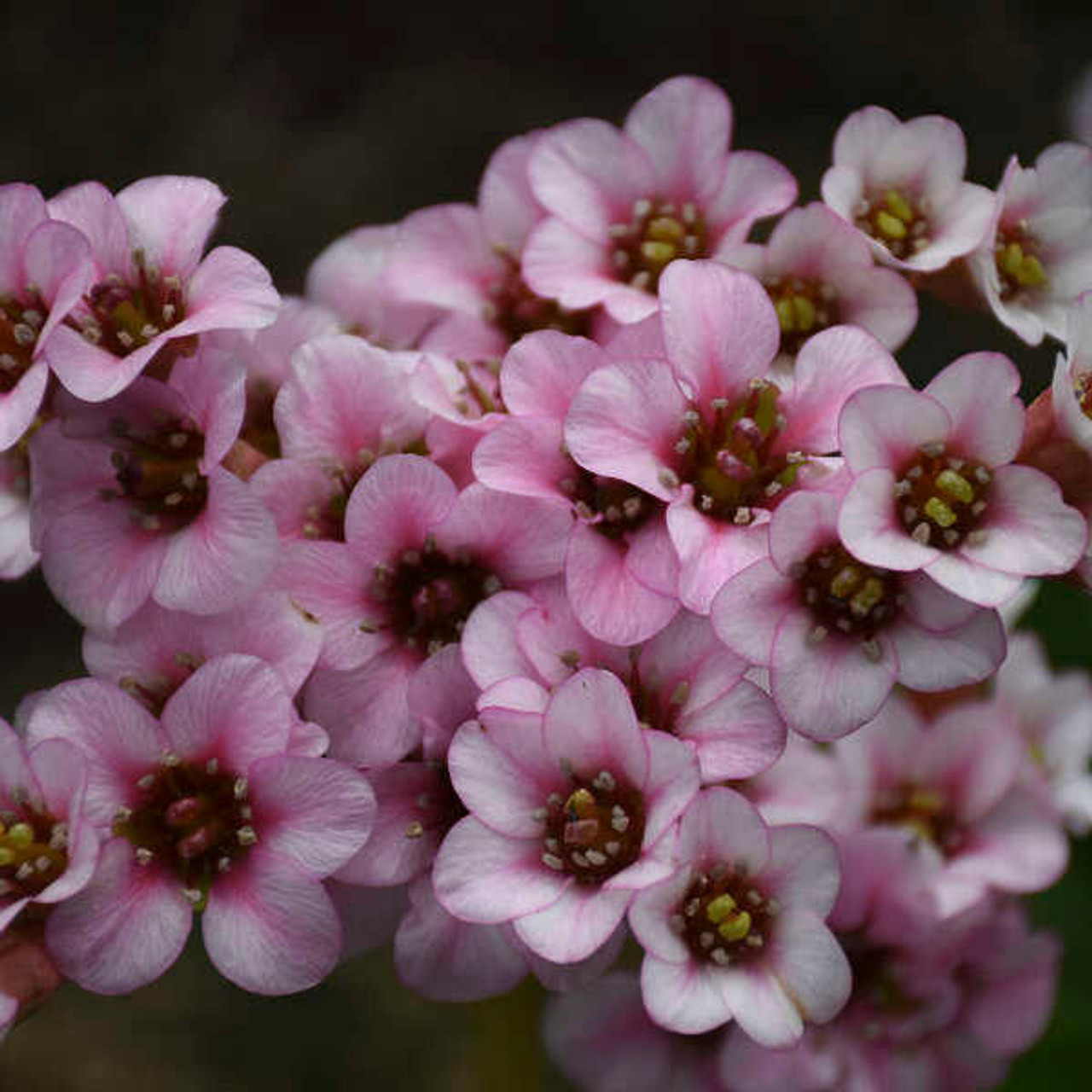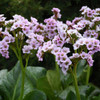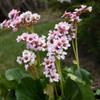Product Description
Bergenia 'Peppermint Patty' PPAF CPBRAF - Proven Winners® (20)ct Flat
Common Name: Pigsqueak, Heartleaf Bergenia
Bergenia 'Peppermint Patty', also known by its charming common names Pigsqueak and Heartleaf Bergenia, is a truly distinctive and robust evergreen perennial that brings unique beauty to the garden. This Proven Winners® selection stands out with its exceptionally intricate and visually appealing blooms. The substantial one¼" wide white flowers are graced with a captivating pink throat, from which the color subtly radiates down each individual petal. A delicate, matching thin pink picotee margin then outlines each petal, adding a refined touch. These striking flowers are held aloft on bright rose-pink stems that gradually transition to green towards their base, providing an additional layer of color contrast. The foliage is equally remarkable; its extra-thick, wavy, and serrated leaves boast prickly-toothed edges, contributing to the plant's overall textured appearance. 'Peppermint Patty' is a reliable, low-maintenance choice that is both rabbit and deer resistant, making it an excellent addition for a wide range of garden settings.
- Foliage: The leaves are evergreen, extra-thick, wavy, and exhibit serrated edges with a distinctive prickly-toothed margin. They are a vibrant green shade, providing year-round interest.
- Flowers: Individual flowers are large, measuring approximately one¼" wide. They are primarily white with a prominent pink throat, pink coloration radiating down the petals, and a thin pink picotee margin.
- Stems: Flower stems are a bright rose-pink near the blooms, transitioning to green towards the base.
- Habit: Forms a spreading clump of foliage, making it an effective ground cover.
- Height: Reaches a mature height of approximately 22.0 inches.
- Spread: Spreads to a width of 16.0-18.0 inches.
- Flower Color: A delightful combination of white and pink shades.
- Foliage Color: Predominantly green shades.
- Bloom Time: Blooms from early spring to late spring, offering vibrant color when many other plants are just emerging.
- Growth Rate: Exhibits a medium growth rate, establishing well overtime.
- Seasonal Interest: Provides evergreen interest throughout the year, ensuring continuous appeal in the landscape.
- Attracts: Attracts butterflies and is considered bee-friendly, contributing to pollinator health.
- Resists: Highly resistant to both deer and rabbits, a significant advantage for gardeners in areas with wildlife pressure.
- Salt Tolerant: Demonstrates good salt tolerance, making it suitable for coastal areas or roadside plantings where salt may be an issue.
- Botanical Name: Bergenia 'Peppermint Patty'
- Patent/Trademark: PPAF CPBRAF - Proven Winners®
- Common Names: Pigsqueak, Heartleaf Bergenia. The common name "Pigsqueak" comes from the sound made when rubbing two leaves together.
While 'Peppermint Patty' is a cultivated variety, Bergenia species are generally native to Central Asia, from Afghanistan to China and the Himalayan region. They typically thrive in rocky, woodland, and mountainous areas, often found in partial shade and on well-drained but consistently moist soils. This lineage contributes to their inherent hardiness and adaptability in various garden conditions.
Landscaping Design Tips
Bergenia 'Peppermint Patty' is an incredibly versatile plant for landscape design, offering both textural and floral interest.
- Mass Planting: This plant excels in mass planting, creating a lush, evergreen carpet. Planting in drifts of 5-7 or more plants allows their unique foliage texture and abundant spring flowers to make a significant visual impact. When mass planted, the effect of their wavy, toothed leaves provides an interesting ground plane, and the springtime bloom display is truly spectacular, forming a sea of pink and white. Mass plantings are particularly effective under deciduous trees or along pathways where their evergreen nature provides year-round structure.
- Borders and Edging: Its tidy, clumping habit and medium height make it an ideal choice for the front of borders or as a distinctive edging plant along walkways, driveways, or garden beds. The evergreen foliage provides a clean, defined line.
- Containers: 'Peppermint Patty' performs beautifully in containers, either as a standalone specimen or as a "filler" and "spiller" in mixed arrangements. Its unique foliage and spring flowers add character to patio pots and window boxes.
- Ground Cover: Due to its spreading nature and dense foliage, it functions as an effective ground cover, especially in shaded or partially shaded areas, helping to suppress weeds and reduce soil erosion.
- Cut Flower: The charming and long-lasting blooms make excellent cut flowers, bringing a touch of early spring beauty indoors.
- Easy to Grow: Its low maintenance requirements make it suitable for both novice and experienced gardeners.
- Salt Tolerant: Plant it in areas that might experience salt spray from roads or pathways.
- Underplanting: Excellent for underplanting deciduous trees and shrubs, where it can provide evergreen interest during the dormant season of the upper canopy.
- USDA Hardiness Zones: Hardy in USDA Zones 4, 5, 6, 7, and 8. This indicates a broad range of climates where it can successfully overwinter, tolerating temperatures down to -30°F to -20°F (Zone 4).
Planting and Cultivation
- Light Requirements: Adaptable to a wide range of light conditions, from Full Sun (> 6 hours of direct sun) to Full Shade (< 4 hours of direct sun). For optimal flowering and foliage color, a location with partial shade (4-6 hours of direct sun, especially morning sun) is often ideal, as intense afternoon sun in warmer climates can sometimes scorch the leaves.
- Soil Quality: Prefers average to fertile soil quality. It is crucial that the soil is well-drained to prevent root rot, especially in shadier conditions. Amending heavy clay soils with organic matter will improve drainage.
- Water Needs: Has average water needs. Once established, it is relatively drought tolerant but will perform best with consistent moisture, especially during dry periods. Avoid excessively wet conditions, particularly in winter.
- Planting: When planting, dig a hole twice as wide as the root ball and just as deep. Place the plant so the top of the root ball is level with the soil surface. Backfill with soil, gently firming around the base of the plant. Water thoroughly after planting.
- Fertilization: A light application of a balanced, slow-release granular fertilizer in early spring can promote vigorous growth and flowering.
- Maintenance: Generally low maintenance. Remove any spent flower stalks after blooming to encourage plant vigor and maintain a tidy appearance. Dead or damaged leaves can be removed as needed. Division every 3-5 years in early spring or fall can rejuvenate older clumps and provide new plants.
Other Details
The most important part of the plant is its root system. Healthy roots are the foundation of a healthy, vibrant plant. The type of plug container used is based on the specific needs of the plants. Perennials offered as bare root traditionally perform better when planted as bare root.Planted in a specialized mix, potted plants have well established root systems. Top growth stage will vary depending on the current life cycle and time of year when shipped. In Winter and early Spring dormant plants may be shipped. Dormant plants may be planted right away, even before the last frost date.
Most bare root varieties are field grown for at least one season, though Hemerocallis and Hosta are grown for two seasons. The bulk of the soil is removed during the harvesting process and the tops of most varieties are trimmed back to the crown. They are graded, packed in shredded aspen or sphagnum moss and stored in freezers until ready to be shipped.
See our Container Sizes and Bare Root Perennials pages for more information.
Plant information and care is provided in the Overview section, Plant Genus Page and general information is provided in the Planting Care & Guides. Additional questions can be asked on each Plant page.
Plant Spacing: Using the maximum mature spread or width of a plant to guide spacing, ensures space to grow to full size. To fill an area sooner, plant them closer together. Just remember, future thinning or transplanting may be needed.
Water: Keep a close eye on newly planted perennials, especially throughout the first growing year. Most early plant loss is due to too much or too little water!












